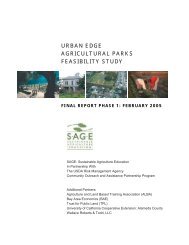A Feasibility Study for Urban Edge Agricultural Parks - SAGE
A Feasibility Study for Urban Edge Agricultural Parks - SAGE
A Feasibility Study for Urban Edge Agricultural Parks - SAGE
Create successful ePaper yourself
Turn your PDF publications into a flip-book with our unique Google optimized e-Paper software.
development.Economics/Sources of FundingThe 1979 bond issue <strong>for</strong> $50 million has funded an extensive network of farmlandpreservation easements. Additional funds have been obtained from a 1995 Artsand Natural Resources Initiative ($1.8 million), the Washington Futures Tax ($1million), and USDA ($475,000).The FPP operates with a single staff coordinator position, which was funded by theCounty’s General Fund until about five years ago. This position is now funded by awater levy fee that was implemented to mitigate drainage issues.Since the bond funds were expended, the FPP has entered a relatively stable phaseof smaller, diverse funding from local sources, enabling development rightsacquisition <strong>for</strong> one or two properties per year. The staff position is vulnerable toreductions in fee collection and budget allocation of the General Fund.Lessons LearnedThis program was made possible primarily by thelarge bond funding in 1979. An interview withthe FFP coordinator indicated that a majorchallenge to the program is the lack of supportivezoning. If zoning allows <strong>for</strong> development, theprice of the easement is relatively high.Moreover, if agriculture is not profitable,easements alone do not ensure that propertiesare actively farmed.Other constraints include lack of language in the bond to allow <strong>for</strong> habitatrestoration or transfer of development rights to achieve this goal.DRAFT 1.6.05 71





